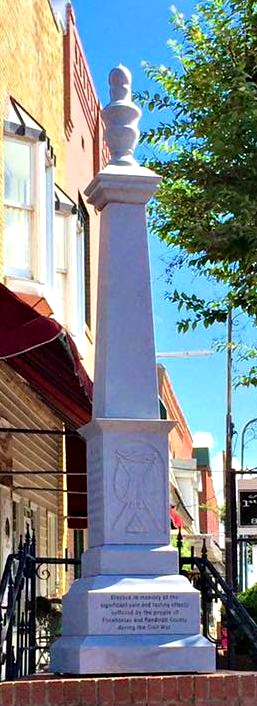5fish
Well-Known Member
- Joined
- Jul 28, 2019
- Messages
- 10,690
- Reaction score
- 4,551
Here is a well documented skirmish...

 encyclopediaofarkansas.net
encyclopediaofarkansas.net
Skirmish at Pitman's Ferry
On October 27, 1862, Union Colonel William Dewey surprised Confederate Colonel John Q. Burbridge’s Brigade at Pitman’s Ferry (Randolph County). Dewey’s rapid combined-arms attack temporarily won control of the ferry and allowed for the reconnoitering of the Pocahontas (Randolph County) area. This was the last major Civil War engagement in Randolph County.
The location of Pitman’s Ferry on the Current River made it an important possession for the antagonists in Arkansas. Settled by William Hix about 1803, the location served as the key entry point from Missouri on the Southwest Trail (also called the Military Road, Congress Road, or the Natchitoches Trace) into northeast Arkansas. Purchased by Dr. Peyton Robinson Pitman before Arkansas statehood, Pitman’s Ferry had a strategic importance that made it a natural assembly point for Confederate volunteers. From the site, troops not only could defend the ferry but could shift rapidly toward the Mississippi or White rivers. Consequently, Confederates mustering around Pocahontas and near the ferry outnumbered the civilian populace of the county in 1861, with some estimates exceeding 10,000 troops in total. Confederate Major General William J. Hardee took command at Pitman’s Ferry, transferring most of the volunteers into Confederate service before shifting them east of the Mississippi River in late 1861 to defend Tennessee and Kentucky. Thus, this avenue of entry remained weakly defended.
Four skirmishes occurred at Pitman’s Ferry in 1862—on April 1, July 20, October 27, and November 25. The best documented engagement occurred October 27. Intending to project a Union force into Randolph County and strike any available targets, Dewey’s Twenty-third Iowa Infantry left Camp Patterson in Missouri with a conglomeration of the thirteen infantry and cavalry companies and one artillery battery. Dewey planned to take Pitman’s Ferry and link with Lieutenant Colonel Bazel F. Lazear’s force moving into Randolph County from another direction. Once combined, they would coordinate attacks on available targets and reconnoiter Pocahontas.
Trying to surprise the Confederates, Dewey moved with haste but made contact with Confederate forces seventeen miles from Pitman’s Ferry in Missouri. Realizing that his element of surprise was jeopardized, Dewey dispatched elements of the Twenty-fifth Missouri Infantry to seize the Missouri side of the ferry. About ten miles from the site, another Confederate force was surprised and captured. Thus, through quick, bold action, the Twenty-fifth Missouri reached the ferry undetected. Once it was in place, Private Richard Lloyd quietly swam the Current River to take the boat to the Missouri side.
Near 8:00 a.m. October 27, the Confederate force reported to be Burbridge’s Brigade aligned for battle on the Arkansas side of the river. Dewey formed his line straddling the road about 100 yards from the ferry in Missouri. Deploying his artillery in the center, Federal troops began firing on the Confederate artillery deploying over the river, effectively scattering it and weakening the determination of the defenders. The Twenty-third Iowa positioned itself on the bank to deliver cover fire for the Twenty-fifth Missouri, which crossed the river and lightly skirmished with the Confederates, forcing them to retreat.
In possession of the ferry, Dewey ordered his exhausted men into camp, as they had covered sixty-five miles in two and a half days. On October 29, Dewey linked with Lazear at Bollinger’s Mill, about fifteen miles inside Randolph County, before sending reconnoitering parties toward Pocahontas. On October 30, Dewey began his return to Camp Patterson, reaching the site on November 2.
Estimates place the number of engaged near 2,500, but exact totals cannot be determined. Union reports fail to emphasize the number engaged or lost, and Confederate accounts do not exist. Confederate casualties listed in the Union reports are vague, listing forty prisoners, including two colonels referred to as “Colonel Greene, of St. Louis, and Campbell, of Springfield.” Another Federal account lists the Confederate colonels at Pitman’s Ferry as Burbridge, Greene, and Mitchell—with no reference to Campbell. Until adequate Confederate accounts are located, no one can be sure whom the Confederates were at Pitman’s Ferry.
Pitman’s Ferry continued to change hands until the site fell deep behind Union lines in 1863. Afterward, only occasional raids and guerrilla activity attracted attention to the location.
Two markers are near the site, but the actual location is in private hands.

Encyclopedia of Arkansas
On October 27, 1862, Union Colonel William Dewey surprised Confederate Colonel John Q. Burbridge’s Brigade at Pitman’s Ferry (Randolph County). Dewey’s rapid combined-arms attack temporarily won control of the ferry and allowed for the reconnoitering of the Pocahontas (Randolph County) area...
Skirmish at Pitman's Ferry
| Location: | Randolph County |
| Campaign: | None |
| Date: | October 27, 1862 |
| Principal Commanders: | Colonel William Dewey (US); Colonel John Q. Burbridge (CS) |
| Forces Engaged: | Elements of the Twenty-third Iowa Infantry, Twenty-fourth Missouri Infantry, Twenty-fifth Missouri Infantry, the First Missouri State Militia, the Twelfth Missouri Volunteer Cavalry, and Stange’s Battery (estimated 1,000 plus) (US); Burbridge’s Brigade (estimated 1,500) (CS) |
| Estimated Casualties: | Unknown (US); Unknown killed, forty prisoners (CS) |
| Result: | Union victory |
The location of Pitman’s Ferry on the Current River made it an important possession for the antagonists in Arkansas. Settled by William Hix about 1803, the location served as the key entry point from Missouri on the Southwest Trail (also called the Military Road, Congress Road, or the Natchitoches Trace) into northeast Arkansas. Purchased by Dr. Peyton Robinson Pitman before Arkansas statehood, Pitman’s Ferry had a strategic importance that made it a natural assembly point for Confederate volunteers. From the site, troops not only could defend the ferry but could shift rapidly toward the Mississippi or White rivers. Consequently, Confederates mustering around Pocahontas and near the ferry outnumbered the civilian populace of the county in 1861, with some estimates exceeding 10,000 troops in total. Confederate Major General William J. Hardee took command at Pitman’s Ferry, transferring most of the volunteers into Confederate service before shifting them east of the Mississippi River in late 1861 to defend Tennessee and Kentucky. Thus, this avenue of entry remained weakly defended.
Four skirmishes occurred at Pitman’s Ferry in 1862—on April 1, July 20, October 27, and November 25. The best documented engagement occurred October 27. Intending to project a Union force into Randolph County and strike any available targets, Dewey’s Twenty-third Iowa Infantry left Camp Patterson in Missouri with a conglomeration of the thirteen infantry and cavalry companies and one artillery battery. Dewey planned to take Pitman’s Ferry and link with Lieutenant Colonel Bazel F. Lazear’s force moving into Randolph County from another direction. Once combined, they would coordinate attacks on available targets and reconnoiter Pocahontas.
Trying to surprise the Confederates, Dewey moved with haste but made contact with Confederate forces seventeen miles from Pitman’s Ferry in Missouri. Realizing that his element of surprise was jeopardized, Dewey dispatched elements of the Twenty-fifth Missouri Infantry to seize the Missouri side of the ferry. About ten miles from the site, another Confederate force was surprised and captured. Thus, through quick, bold action, the Twenty-fifth Missouri reached the ferry undetected. Once it was in place, Private Richard Lloyd quietly swam the Current River to take the boat to the Missouri side.
Near 8:00 a.m. October 27, the Confederate force reported to be Burbridge’s Brigade aligned for battle on the Arkansas side of the river. Dewey formed his line straddling the road about 100 yards from the ferry in Missouri. Deploying his artillery in the center, Federal troops began firing on the Confederate artillery deploying over the river, effectively scattering it and weakening the determination of the defenders. The Twenty-third Iowa positioned itself on the bank to deliver cover fire for the Twenty-fifth Missouri, which crossed the river and lightly skirmished with the Confederates, forcing them to retreat.
In possession of the ferry, Dewey ordered his exhausted men into camp, as they had covered sixty-five miles in two and a half days. On October 29, Dewey linked with Lazear at Bollinger’s Mill, about fifteen miles inside Randolph County, before sending reconnoitering parties toward Pocahontas. On October 30, Dewey began his return to Camp Patterson, reaching the site on November 2.
Estimates place the number of engaged near 2,500, but exact totals cannot be determined. Union reports fail to emphasize the number engaged or lost, and Confederate accounts do not exist. Confederate casualties listed in the Union reports are vague, listing forty prisoners, including two colonels referred to as “Colonel Greene, of St. Louis, and Campbell, of Springfield.” Another Federal account lists the Confederate colonels at Pitman’s Ferry as Burbridge, Greene, and Mitchell—with no reference to Campbell. Until adequate Confederate accounts are located, no one can be sure whom the Confederates were at Pitman’s Ferry.
Pitman’s Ferry continued to change hands until the site fell deep behind Union lines in 1863. Afterward, only occasional raids and guerrilla activity attracted attention to the location.
Two markers are near the site, but the actual location is in private hands.


